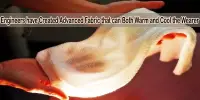While silk is best recognized for its use in clothing and fabrics, the material has a wide range of applications, from biomedicine to environmental research. Tufts University researchers examine the properties of silk and its current and potential applications in Applied Physics Reviews, published by AIP Publishing.
For almost 5,000 years, silk has been a sought-after fabric. It’s delicate, glossy, and lovely, making it ideal for scarves, blouses, and dresses. Since then, silk has been produced mostly in Asia, but sericulture has grown in popularity throughout the world as the years have passed.
Silk production today represents for less than 0.2 percent of the global fiber market, yet it is a multibillion-dollar business. Silk is a valuable biomaterial since it does not elicit an immunological response in humans and encourages cell proliferation.
It has been utilized in drug delivery, and it is perfect for wearable and implantable health monitoring sensors due to its flexibility and attractive technological qualities.
Silk is valuable in optics and electronics because it is an optically transparent and easily controlled material at the nano and microscale. Among other things, it’s used to make diffractive optics, photonic crystals, and waveguides.
One big challenge is that nature is very good at doing things, like making silk, but it covers an enormous dimensional parameter space. For technology, we want to make something with repeatability, which requires being able to control a process that has inherent variability and has been perfected over thousands of years.
Fiorenzo Omenetto
Silk has recently risen to the forefront of environmental studies. Nature created the substance, which may be reprocessed from recycled or abandoned garments and other fabrics. Silk coatings may also help to reduce food waste, which accounts for a major portion of the worldwide carbon footprint.
“We are continuing to improve the integration between different disciplines,” said author Giulia Guidetti.
“For example, we can use silk as a biomedical device for drug delivery but also include an optical response in that same device. This same process could be used someday in the food supply chain. Imagine having a coating which preserves the food but also tells you when the food is spoiled.”
Because silk may be chemically manipulated and tailored for certain qualities or constructed into a specific form depending on its eventual application, it is adaptable and frequently superior to more traditional materials.
Silk has unique characteristics, but it also presents a number of ethical and environmental concerns. Silk is also one of the most expensive textiles, and it necessitates frequent dry-cleaning. Controlling and maximizing these qualities, on the other hand, requires a grasp of the material’s genesis.
Silkworms’ bottom-up manufacture of silk has been studied for a long time, yet a complete understanding of its construction remains elusive. The researchers underlined the importance of understanding these processes since it may help them build the material more efficiently and manage the ultimate function.
“One big challenge is that nature is very good at doing things, like making silk, but it covers an enormous dimensional parameter space,” said author Fiorenzo Omenetto. “For technology, we want to make something with repeatability, which requires being able to control a process that has inherent variability and has been perfected over thousands of years.”
Silk is expected to be used in more materials and technologies in the future, possibly as an intrinsic component of sensors that collect emergent data on humans and the environment, according to the researchers.
















